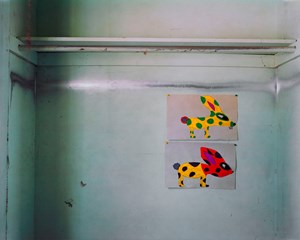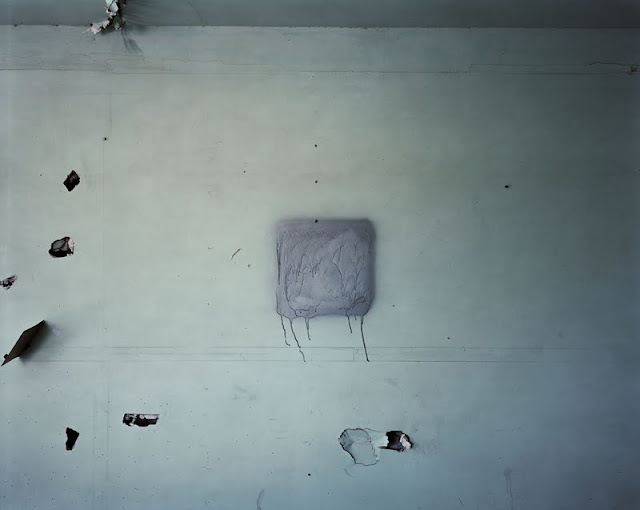
Eight large works by prolific photographer John Divola command the small space of Gallery Luisotti in Santa Monica, offering a glimpse into what is perhaps one of the artist’s most familiar obsessions – turning abandoned space into abstract works of art via personal intervention. The works compiled in Dents and Abrasions represent individual pieces from prior series created in the first decade of the new millennium that all revisit Divola’s early seminal series Vandalism.
Eight large works by prolific photographer John Divola command the small space of Gallery Luisotti in Santa Monica, offering a glimpse into what is perhaps one of the artist’s most familiar obsessions – turning abandoned space into abstract works of art via personal intervention. The gutted remains of long forgotten homes in stark landscapes are given new life as a canvas for Divola’s random brushstroke, line drawing, or placement of found objects that in turn mingle with and highlight pre-existing marks and flaws of unknown origin. The dents and abrasions of the show’s title are both old and new, combining within a resulting photograph to compel notions of the possibilities of place as an existential document of time and space created by the interlocutor.
The works compiled in Dents and Abrasions represent individual pieces from prior series created in the first decade of the new millennium that all revisit Divola’s early seminal series Vandalism. According to Gallery Luisotti, with Vandalism, Divola “created a phenomenal and ambitious body of work that entailed entering uninhabited homes, spray-painting geometric shapes and/or patterns on the homes’ walls, and photographing the markings in black-and-white. The work subverted the basic preconception of photographic documentation by bringing to the fore photography’s inherent surface tension: a space that lies between an illusory and enigmatic subject matter (the spray painted marks) and the evidentiary signs of exurban abandonment.”
We spoke with Divola to uncover the roots of this ongoing foray into these spaces within the realm of his overall oeuvre.
Artdependence Magazine: What weaves the work in this series Dents and Abrasions together?
John Divola: These works are all from series done concurrently that are characterized by specificity of procedure in which I took an 8 x 10 view camera into abandoned buildings. Once inside these spaces, I would mark or place something on the walls and explore the possibilities presented. Looking at these pieces together I can find within the constellation of images that I had an interest in the context of the desert or a romantic notion of place. But really they are an investigation into the possibility of procedure.

March Housing B, 2007. Archival inkjet print on Dibond aluminum. 44 x 54 inches © John Divola

Intervention G, 2007. Archival inkjet print on Dibond aluminum. 44 x 54 inches © John Divola
AD: In the pieces culled from your Abandoned Paintings series, in which you hang discarded works of student art upon the walls of these homes, you are giving the paintings a new life and exposure that their creator hadn’t originally destined for them. How does that speak to the individual presence that is embodied within a structure dependent upon its occupant or, in your case, perhaps its intruder?
JD: Like most things it came from opportunity and observation. I am already going into spaces and marking or changing them so it is not a huge leap to bring in object. I came across these abandoned paintings in the dumpster while teaching at UC Riverside. Someone had decided to go into the storeroom and get decades of old paintings and throw them away.
Even when I paint something myself there is a certain license given by distance, I can paint a naïve mark and I can make an interesting photograph about that naïve gesture. If I take a panting, which is already imbued with desire and in many cases failure, there is great pathos in the object. I can put it on wall and see how it interacts with the sense of place figuratively and in terms of a broader sense of place, I can examine or experiment with the possibilities that are presented.

Wonder Valley, CA, 4/27/2014, 3:35-3:40PM, 2014. Archival inkjet print on Dibond aluminum. 30 x 54 inches © John Divola

Intervention K, 2008. Archival inkjet print on Dibond aluminum. 36 x 44 inches © John Divola
AD: How do the existing marks and flaws of these abandoned homes influence the kinds of marks or interventions you then perform in the space for the resulting photograph? Describe the collaboration with what the space offers.
JD: It is subjective. Before photography painting was about representation literally or allegorically then as photography came on the scene in the early 1800s it was a more efficient way to document. Painting became more about gesture and abstraction. Through my gesture of painting a square alongside the gestures of others, like a hole kicked in a wall, I am dealing with how my gestures interact with the indexes and marks of others. A dent, abrasion or hole is indexing another human being and my actions are in some kind of dialogue with their actions. This becomes as subjective as any abstract painting.
AD: I am reminded of the human body while viewing these works. Particularly in how our bodies become visual maps of our lived experience and even more specifically a narrative of the histories we have inflicted upon ourselves? There are scars, wounds and all the ensuing damage of existence, but also the beauty of our own personal, physical landscapes. Your photograph of the bulging house makes me feel as if it is bursting with its stories from its years of standing. Do the homes ever speak to you? What do you feel while entering these old bones?
JD: That is a complicated question. It is different every time. Sometimes I am nervous because I really shouldn’t be there. Sometimes I am merely excited about the potential of the space. Sometimes I am melancholy with a sense of somebody having left that space.

Intervention J, 2008. Archival inkjet print on Dibond aluminum. 36 x 44 inches © John Divola

Intervention D, 2007. Archival inkjet print on Dibond aluminum. 44 x 54 inches © John Divola
AD: How has your experience within these abandoned places lent to the own evolution of your work from “Vandalism” to now? What has changed and what has stayed the same for you in this process?
JD: For a long time I gave up the idea of these interventions. The only thing that is consistent in all my work is my interest in relationship between specific and abstract. If you paint a goat it is an emblem of goatness but if you photograph a goat it can be an emblem but it is one goat in one time and one place. Photography provides a specificity of time, place and circumstance but it is also abstract and symbolic. That relationship is the continuity. The idea of doing more of this work came while working on a book for Aperture about my work in the 1970s. I got interested in it again.
What is different is the technology. Today I can use a drum scanner to reproduce an 8 x 10 negative and print pigment directly onto rag paper. The scale, color and materiality have changed. The procedures are similar but the tools have evolved.
AD: What, in the end, do you hope to convey with this work?
JD: There is a great quote about poetry, “A poem is about something the way a cat is about a house.” What I want to do is come back with an artifact of an engagement. I want to engage people conceptually and literally. I offer opportunities for observation so I want people to follow my sense of observing and choosing but I also want them to engage in speculation about the process in these artifacts I generate.

Abandoned Painting A, 2007. Archival inkjet print on Dibond aluminum. 44 x 54 inches © John Divola

Intervention C, 2007. Archival pigment print on Dibond aluminum. 44 x 54 inches © John Divola
AD: What are you currently working on or obsessed by that we may see next?
JD: For a little over a year, I have been working at an abandoned air force base housing precinct at George Air Force Base. It is a community designed by the architect A Quincy Jones that was developed at the end of World War II to primarily train cold war fighter pilots. In the ‘90s it was closed down. It is a super fun site contaminated with jet fuel where bulldozers have knocked down all the trees and bushes between the buildings. I am still in the process of exploring.
Dents and Abrasions runs through May 14th.

ArtDependence Magazine is an international magazine covering all spheres of contemporary art, as well as modern and classical art.
ArtDependence features the latest art news, highlighting interviews with today’s most influential artists, galleries, curators, collectors, fair directors and individuals at the axis of the arts.
The magazine also covers series of articles and reviews on critical art events, new publications and other foremost happenings in the art world.
If you would like to submit events or editorial content to ArtDependence Magazine, please feel free to reach the magazine via the contact page.